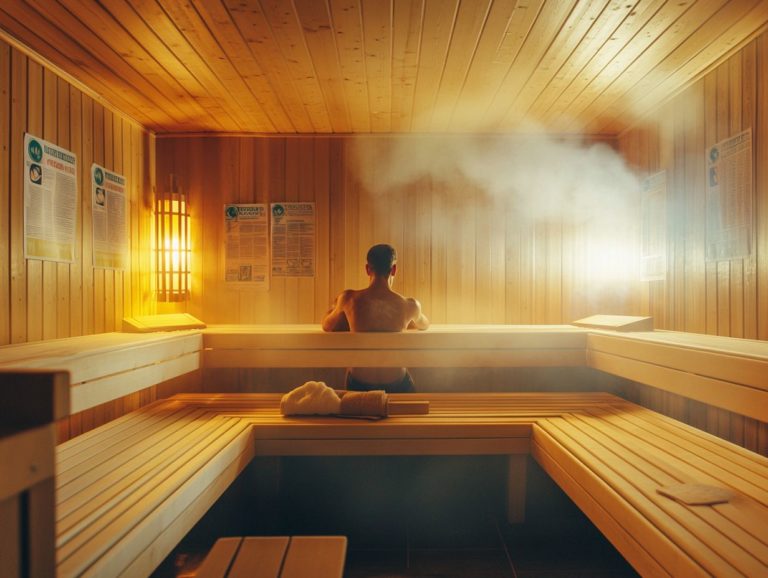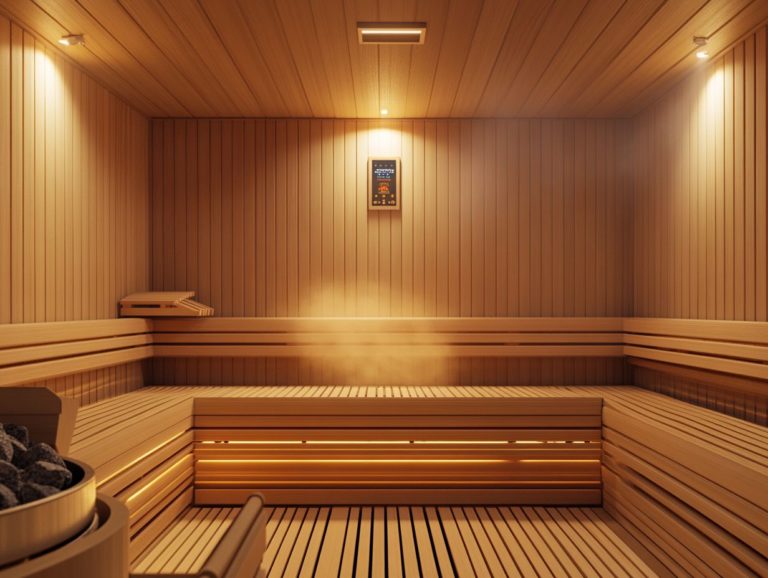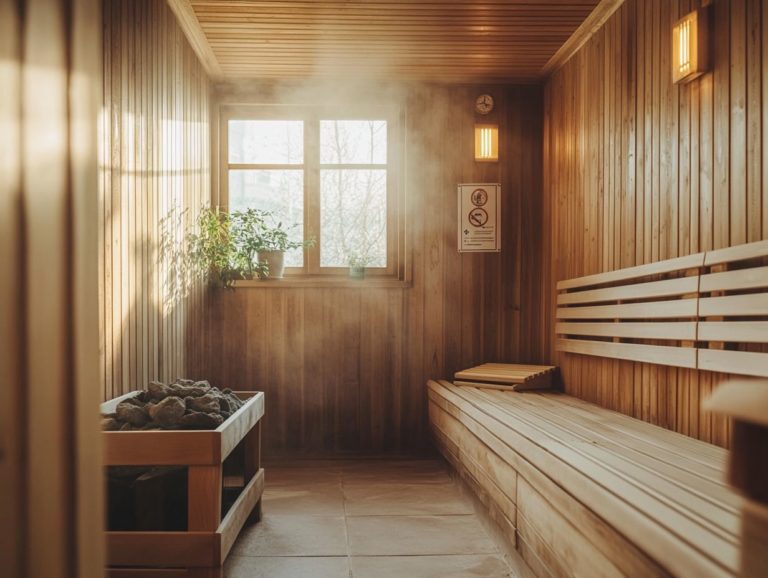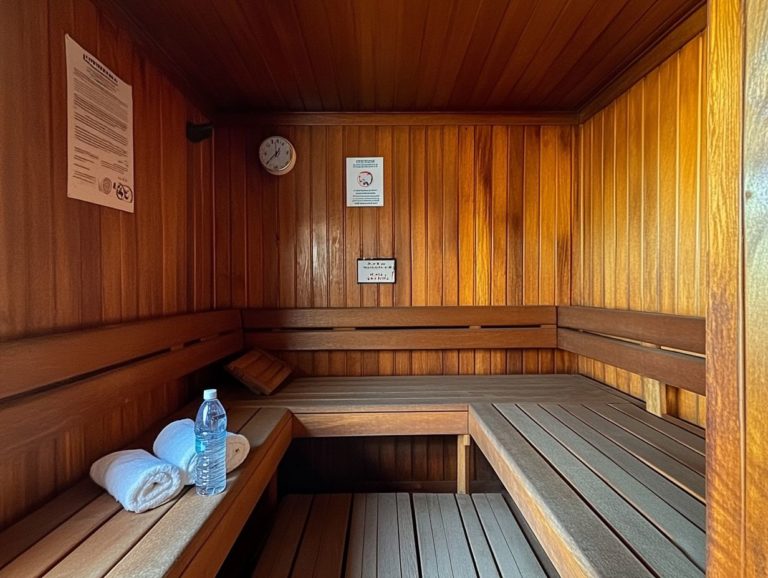Sauna Safety: The Role of Responsible Ownership
Saunas provide a great mix of relaxation and health benefits, yet knowing how to stay safe in a sauna is crucial for an amazing experience.
This exploration delves into what a sauna is and the many physical and mental benefits it offers. However, it s equally important to be aware of potential risks, such as overheating and dehydration.
You ll also find insights into the responsibilities that come with sauna ownership, from proper installation to ongoing maintenance, along with essential safety precautions for users. Immerse yourself in this information to ensure you enjoy your sauna experience safely and effectively.
Contents
- Key Takeaways:
- Understanding Sauna Safety
- Benefits of Sauna Use
- Potential Risks of Sauna Use
- Responsible Ownership of a Sauna
- Safety Precautions for Sauna Users
- Frequently Asked Questions
- What is the role of responsible ownership when it comes to sauna safety?
- What are the most common safety hazards in a sauna?
- How often should a sauna be inspected for safety?
- What safety measures should be taken when using a sauna?
- What should a responsible owner do in case of an emergency in the sauna?
- How can a responsible owner ensure the safety of all sauna users?
Key Takeaways:

- Responsible ownership of a sauna includes proper installation and regular maintenance to ensure the safety of users.
- Sauna owners should prioritize safety by following guidelines for safe usage and monitoring users for signs of overheating and dehydration.
- The benefits of sauna use can only be fully realized with a responsible and cautious approach to ownership.
Understanding Sauna Safety
Understanding sauna safety is essential for a truly beneficial experience. Whether you’re enjoying a traditional sauna or an infrared sauna, the health benefits can be remarkable think improved blood circulation and relief from muscle pain.
It s crucial to implement proper safety measures and maintain supervision. Without these, you might face serious risks like overheating and dehydration.
By recognizing the importance of safety guidelines, identifying potential hazards such as users overheating, and mastering temperature regulation, you can enhance your experience while minimizing health risks. Prioritizing sauna safety allows you to fully savor the relaxation and wellness benefits it offers.
What is a Sauna?
A sauna is your personal retreat, a small room designed for heat sessions that promote relaxation while offering many health benefits, including stress relief and muscle pain alleviation. You ll find various sauna types to suit your preferences, from traditional steam rooms and infrared saunas to mobile or fixed personal saunas.
These diverse options cater to different needs. Traditional steam rooms envelop you in high humidity and heat, while infrared saunas use light to heat your body directly, offering different benefits compared to traditional methods. Each type has its unique advantages; for instance, steam rooms can be particularly beneficial for those with respiratory challenges, while infrared saunas are often favorites for detoxification.
Saunas also carry profound cultural significance in various regions, such as the Finnish sauna tradition, where the art of socializing melds seamlessly with relaxation. Regular sauna use isn’t merely about comfort; it has been linked to enhanced cardiovascular health, improved circulation, and even skin rejuvenation. For those interested in the role of creativity in sauna safety, it offers a holistic approach to well-being cherished across countless societies.
Benefits of Sauna Use
The benefits of using a sauna go well beyond simple relaxation, making it a favored choice among wellness enthusiasts around the globe. Regular sessions can dramatically enhance your blood circulation, providing relief from muscle pain and promoting your overall physical health.
Research indicates that heat therapy can support weight loss and help alleviate stress, positioning saunas as a versatile asset in your journey toward enhanced well-being. Start your sauna journey today to enjoy these incredible benefits!
Physical and Mental Health Benefits
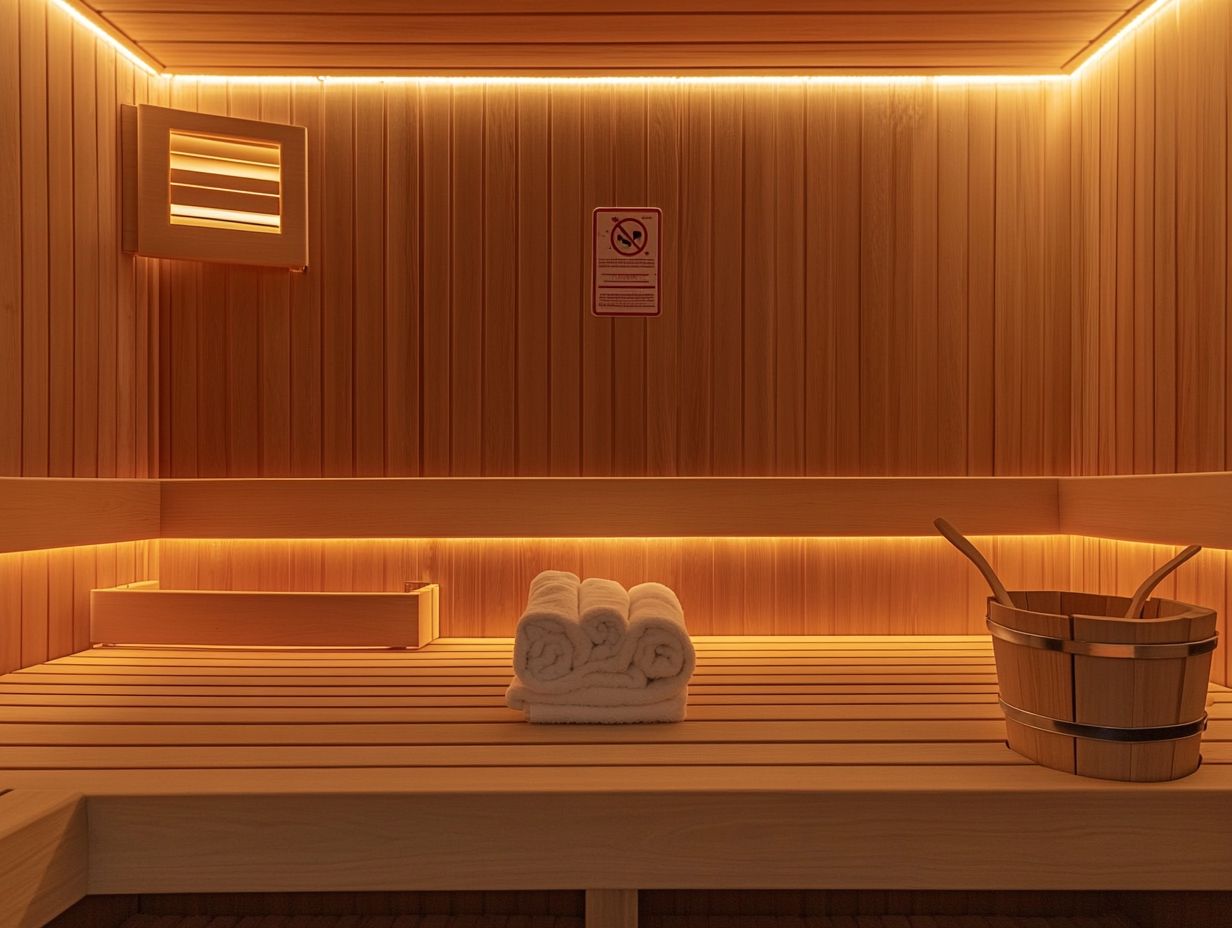
Incorporate regular sauna sessions into your routine for numerous benefits. Sauna use can enhance blood circulation and alleviate muscle pain, offering therapeutic advantages, especially for specific medical conditions.
If you’re dealing with arthritis, you may find significant relief as the heat helps relax tight muscles and reduce joint stiffness. Many who struggle with anxiety and stress report improved mental clarity and a greater sense of well-being after sauna sessions, thanks to the soothing effects of heat therapy.
Research shows that using a sauna regularly can lower blood pressure and decrease the risk of cardiovascular diseases. This makes it a valuable addition to your health regimen, leading to both physical revitalization and mental rejuvenation.
Potential Risks of Sauna Use
Be aware of the potential risks of sauna use. If you don t follow proper safety measures, you could face overheating and dehydration, which may overshadow the benefits.
Overheating and Dehydration
Overheating and dehydration are major concerns during sauna use. Know how to manage your time and temperature to stay safe. Understanding your body s response to heat and maintaining your hydration levels is key to preventing serious health issues.
In the sauna, high temperatures can cause excessive sweating, which is a natural way for your body to cool down. However, it can also lead to significant fluid loss. If you’re not careful, you might experience dizziness, nausea, or even heat stroke. Understanding the influence of sauna safety on wellness is crucial for enjoying your sauna experience safely.
To ensure a safe sauna experience, limit your sessions to no more than 15-20 minutes. Keep a close eye on the heat setting and hydrate well before and after. Be mindful of preheating time for optimal performance. Additionally, understanding sauna safety is essential, as recognizing early signs of discomfort and knowing when to take breaks are crucial for enjoying heat therapy safely.
Responsible Ownership of a Sauna
Owning a sauna means understanding how to maintain it properly. This includes knowing the responsibilities related to sauna maintenance, from electrical needs to the specific requirements of different sauna types. Whether you have a personal sauna or manage one under a rental agreement, proper installation and upkeep are essential.
This approach ensures not only safety but also optimal performance, allowing you to fully enjoy the health benefits of your sauna experience, while considering sauna safety: the role of personal values.
Proper Installation and Maintenance

Proper installation keeps you safe and helps you enjoy your sauna. Follow the guidelines from sauna manufacturers regarding electrical needs and maintenance routines. This can prevent hazards and extend the life of your sauna.
For instance, your electrical setup should comply with local codes. Ensure it has a dedicated circuit breaker suitable for the sauna’s wattage. It’s advisable to consult an experienced electrician for wiring to prevent overloads or electrical fires. Additionally, understanding sauna safety is crucial for a secure experience.
Once your sauna is up and running, regular maintenance is crucial. Check the heating elements for wear and ensure proper ventilation. Keep your sauna clean and dry, particularly around electrical parts, to minimize the risk of mold growth or malfunction.
By conducting regular inspections, you enhance the lifespan of your sauna and ensure it remains a safe sanctuary for relaxation.
Ensuring Safe Usage
Ensuring the safe usage of a sauna requires your careful watch and strict adherence to established safety protocols. This includes regular temperature checks, which means checking the heat level to ensure it’s safe, and thorough inspections for any broken equipment.
Beyond these essential practices, it’s crucial to have a knowledgeable individual present to oversee the experience, particularly when multiple guests are enjoying the sauna at the same time. This oversight ensures that everyone is mindful of their limits and can easily seek assistance if needed, especially regarding signage policies and rental terms for shared facilities. For more information, check out sauna safety and advocacy.
Always follow the manufacturer’s instructions when using rental equipment. For enhanced well-being, consider incorporating sauna safety and mindfulness into your routine. Pay close attention to any specific guidelines regarding temperature settings and session duration.
If any safety concerns arise such as an unusual noise from the equipment or signs of discomfort from users, take immediate action. Don’t wait; take action immediately if you notice any warning signs! Addressing these issues promptly can prevent accidents and contribute to a truly relaxing experience, aligning with established sauna safety guidelines.
Safety Precautions for Sauna Users
Sauna safety is of utmost importance as you seek to indulge in your sessions while minimizing any potential risks. By implementing essential safety tips and adhering to posted signage, you can significantly enhance your sauna experience and ensure optimal temperature regulation, particularly within fitness centers or YMCA facilities.
Guidelines for Safe Sauna Use
Guidelines for safe sauna use are essential for minimizing the risks of overheating and other potential health hazards. Understanding and adhering to these safety tips can transform your sauna experience into a truly enjoyable and beneficial one, maximizing health benefits and promoting weight loss.
Monitor your sauna time carefully. Limit sessions to 15-20 minutes to avoid overheating. Also, think about your personal health conditions, as certain medical issues could increase the risk of adverse effects. For instance, if you have cardiovascular concerns, consulting a healthcare professional before indulging in the sauna is wise. It’s also beneficial to have a support system in place, as highlighted in sauna safety: the role of support networks.
Being aware of signs of overheating, such as dizziness, excessive sweating, or nausea, is crucial. These signals are your body’s way of telling you it’s time to exit. By keeping these guidelines in mind, you can ensure a safer and more fulfilling sauna experience.
Watch this video for more sauna safety tips!
Frequently Asked Questions
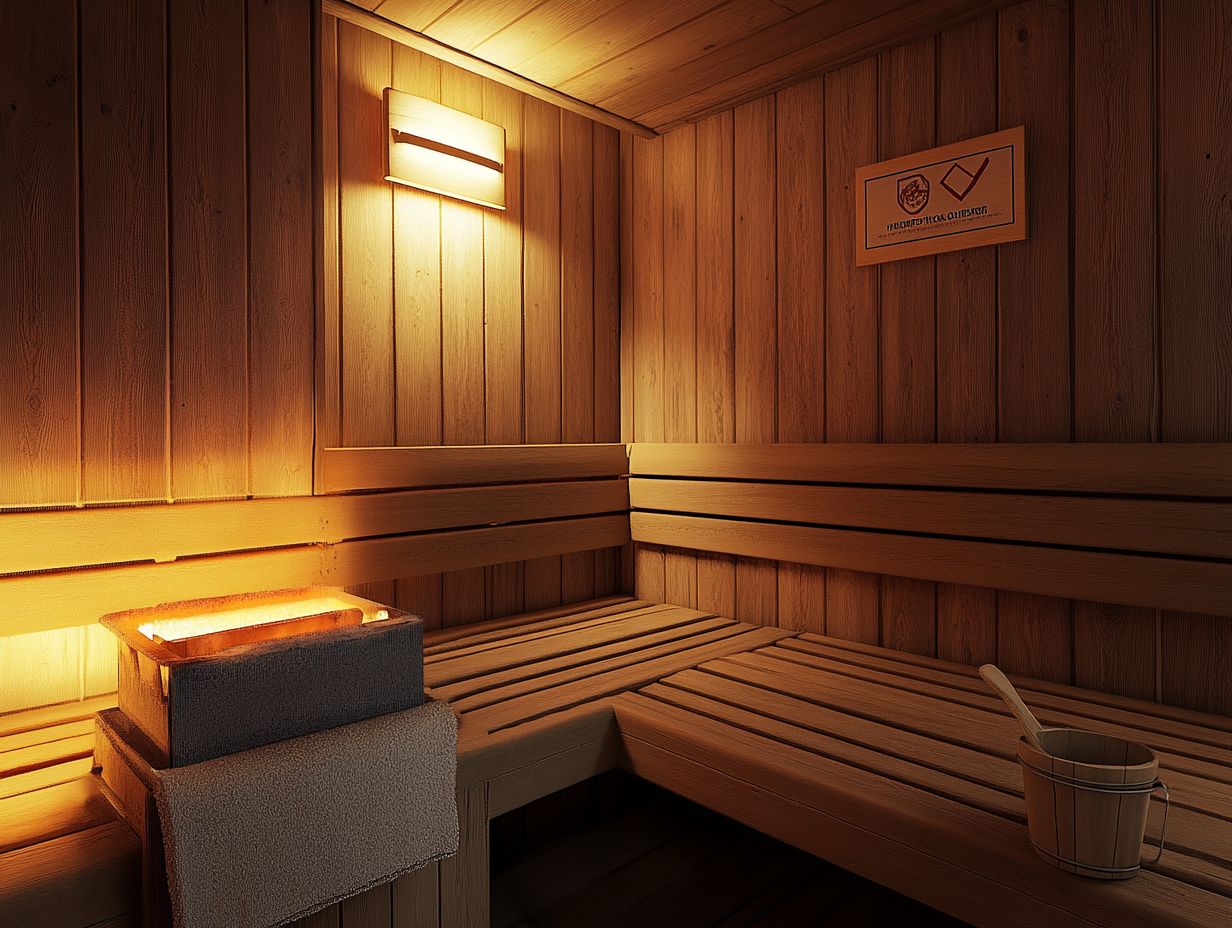
-
What is the role of responsible ownership when it comes to sauna safety?
As an owner, you must maintain and operate the sauna safely and educate users on best practices.
-
What are the most common safety hazards in a sauna?
The most common safety hazards in a sauna include overheating, slipping and falling, dehydration, and improper use of sauna equipment. Address these hazards to avoid accidents.
-
How often should a sauna be inspected for safety?
A sauna should be inspected for safety at least once a month. This includes checking the condition of the sauna equipment, temperature settings, and overall cleanliness. Any necessary repairs or maintenance should be addressed immediately to ensure user safety.
-
What safety measures should be taken when using a sauna?
When using a sauna, follow safety guidelines such as limiting sessions to a maximum of 15-20 minutes, staying hydrated, and not consuming alcohol before or during sauna use. Have a way to quickly cool down, such as a cold shower or a dip in a pool.
-
What should a responsible owner do in case of an emergency in the sauna?
In case of an emergency, have an emergency plan in place and ensure all users are aware of it. This may include having a first aid kit on hand, knowing the location of the nearest phone, and having the necessary training for medical situations.
Enjoy your sauna experience safely! Remember, your health is worth it!
How can a responsible owner ensure the safety of all sauna users?
A responsible owner ensures safety by following guidelines and regularly checking the sauna. Clear instructions on how to use the sauna and warning signs are essential.
It’s also important to teach users how to be safe in the sauna before they use the facility. Taking these steps is crucial for everyone’s safety!

